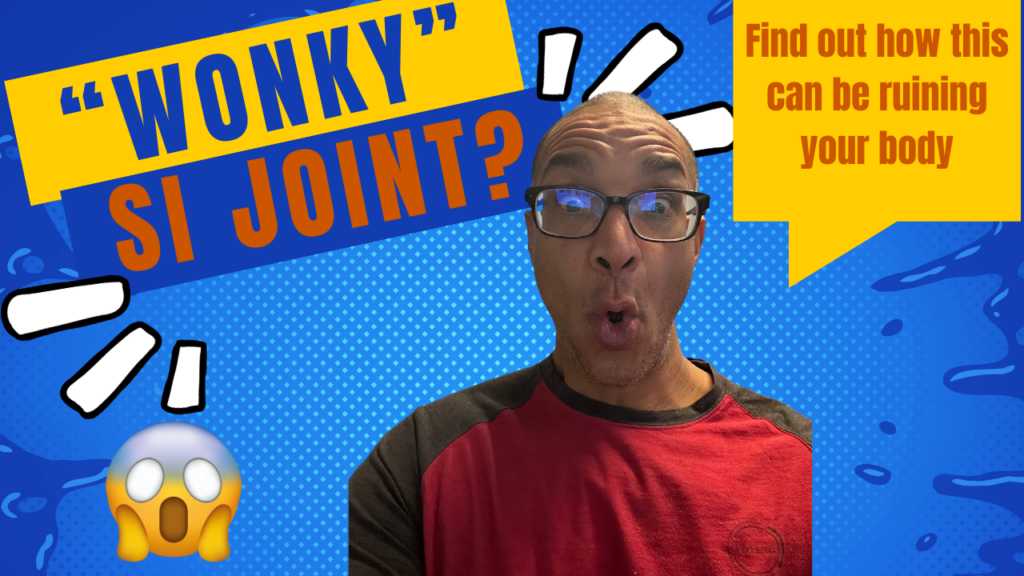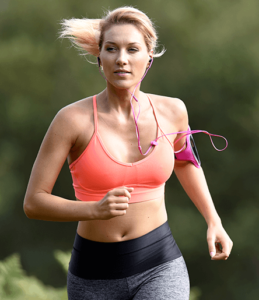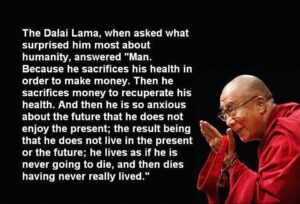Check out the full video below by clicking the image.

SI joint issues can make your life miserable. They can just lean on and on and have constant pain in different places. It is one of the worst things that could happen to your body. It is very difficult to treat and to train, but there is a way, so I want you to listen closely because there is a way to get rid of your SI joint problems and make your life better, which I’ll talk about in this video.
Hi, I’m Ekemba Sooh, I’m the owner of SolCore Fitness. I’m a Summa therapist and a Summa trainer which, to help you understand, it’s kind of like a physical therapist but much more, all under the osteopathic model of which I train. I had SI joint problems, but didn’t know about it, that contributed to my L4-L5 disc compression and sciatic pain. It wasn’t until I started to look at my body holistically and train and treat it holistically, that included the SI joint in a bunch of other places, that I’d get results for my L4-L5 disc compression. The body works and functions holistically and, until you start to train and treat it that way, you won’t get the results you desire. In fact, you might go the other way. If you want to hear more about how to work with your body in this holistic fashion, then subscribe to my channel. Don’t forget to hit that bell so you’re notified. If you like this video, give it a thumbs up, share with your friends, and I’ll post videos about once a week. Thanks so much.
Let’s first all make sure we understand what the SI joint is. SI stands for sacroiliac. Sacrum is the triangle bone that’s between your glutes. Ilium is your hip bone. In between the sacrum and ilium, you have two joints, your sacroiliac joint or SI joint. Those joints look like boomerangs. Those boomerangs are in your back pocket. That’s your SI joint, right here. Now, this is important to understand because this is your pelvis and your SI, that’s your lower back. Pelvis, SI, lower back. I say that because I have a lot of people come to me and go, “Oh, I have back pain,” and they point to their pelvis and SI joint and I go, “No, you don’t, you have an SI joint issue.” That’s important for you to understand too because when you talk to any type of practitioner it’s important to tell them where you actually have pain.
Now, in that joint, you have different parts. So again, remember it’s a boomerang, right? In that boomerang, I have a lesser arm and a greater arm. Like I said, an isthmus in the middle, right? Within that lesser arm, I have an apex and a base, which is right above the isthmus. In the greater arm, I have a base which is right below the isthmus and then an apex. It’s going to be important to understand later on when we talk about dysfunction and why it’s hurting. That SI joint is a total joint. There’s cartilage in there. It’s a total capsule. There’s ligaments to help management, namely the anterior, that means front, sacroiliac ligaments, and the posterior, back, sacroiliac ligaments, and two mini accessory ones called your ilial lumbar ligaments. So if you were to tell me, “Oh, the SI joint is fused,” explain to me why there’s a total joint there, why those ligaments help to manage it? It doesn’t make sense to me to say it’s fused. Now, this is also managed by some muscles so in the front of your sacrum you have your piriformis. In the back of your sacrum, you have your glute max, deep and a little bit superficial, and you have some other muscles that assist with that.
You have your glute med, which attaches to your piriformis. You have your obturator internus, with your piriformis. You have your psoas, with your pelvis, so you have a lot of structures in there that help manage your SI joint. Now, because this joint, this SI joint is a total joint with ligaments that help manage it, it moves. Now, it has two main movements, an oblique movement, that and that, right? It’s called positive torsion, negative torsion, and it works with the ilium. There’s one on the other side but I only have two hands. It does stuff like this on both sides. That’s your main movement. That’s the physiological, you can say, good movement. There’s 20 main pathological movements that can happen to it and a combination of the 20 other pathological movements. Combined, that’s infinite number of ways that it can become dysfunction because if it doesn’t move in that oblique fashion, then that’s where we get SI joint problems.
This joint gets forces on it constantly. Me standing here right now, there’s forces from the ground up to my head, ascending forces that go through the SI joint. There’s also forces that go from gravity and force down through my body, through the SI, going down called descending forces. There’s forces when you sit down on your ischial tuberosity, your sit bones, going through your pelvis into your SI joint. So if you want to have a healthy life and be able to move around, the SI joint needs to be properly functioning. You can have almost an infinite amount of issues with those infinite amount of pathologies at your SI joint. The combinations are almost endless. Take me, for example. I had no sensation in my SI, no pain, nothing like that. I was still moving properly. My pelvis felt good. I was squatting, dead lifting, but a little slight pathology at my SI, which over time caused a big issue at my L4-L5 and disc compression, because the sacrum pulled my spine out of place.
It should be here, the spine’s up here, but it ended up there. And I put the bar on my back and I should be able to transfer forces nicely through my body but it didn’t because it was out of place. But the SI joint could also cause hip pain, knee pain, foot pain. Anywhere in your chain, your body, that you have a weak link, you could have an issue because, again, the body works holistically. I don’t only have a pain if I hit myself there. I can have a pain from somewhere else that causes pain there. The big question is, how do you fix it? You need to find somebody, first, that understands the SI joint and all its different pathologies. You need to understand that the soft tissue around the area controls how well the SI joint is managed.
Just going to somebody to crack and pop it, put it back or to tell you to sit on a foam roller or whatever, that is not going to get it done whatsoever. You need to have somebody go in there and assess what’s going on, and then the main thing you need to do is exercise. Treatment is good, exercise is better. Exercise is going to re-educate the body. Those ligaments I told you about, the anterior, posterior, the iliolumbar ligaments, they’re the smart part of your body, along with the other ligaments. They’re intelligent but they become unintelligent when they become dysfunctional. They have bad information, they have no information, they’re turned off. So you don’t work with just the SI. You don’t go straight to the joint. You don’t just move the sacrum and ilium, try and pop it back into place or roll on something to try to release the muscle like a dumb fashion.
You need to work with those ligaments. That’s going to allow the SI joint to go back in place. But then the most important, like I said, is you need to do exercise. The most effective exercises I come across to work with joints are ELDOA’s. They take a joint in different specific areas and normalize it. Normalize, that means they help put it back in place by using soft tissue. When they help put it back in place by using the soft tissue, through a posture, then they also make the soft tissue and the joint smarter. That’s what you want. You want it to go back in place and be smart so you use an exercise to do that. The therapy will help specifically if something needs a little adjustment here and there, but the exercise is the big thing. Have you been struggling with SI joint issues, have you been able to fix it? Let me know in the comments.
I know you might be feeling a little bit let down because I didn’t give you some formula to follow to fix your SI joint and I apologize. But there’s no formula that you can do for your body to make it better. Your body’s complex. There’s a lot of working parts to go together so on this channel I don’t give people prescriptions, I don’t give people formulas to follow, to correct certain things because everybody’s body is different. It’s a joke in the people who do what I do that whenever somebody comes in we say take off your pants. It’s a joke, but it’s not a joke because any type of overuse injury, I would say the SI is 95% always a part of it, if not the part that causes issues. So again, to give you a recipe would be a disservice to you and probably cause you more issues than you already have.
The best thing to do is to reach out and get some support. Now, you can get some support from me from a multitude of different ways. If you want to join my free Facebook group, then that’s a great way to be interactive to join the group. I interact with members. I do little mini one to three minute trainings, information for you to follow. I do master classes where I take a topic and talk about it and interact with people, ask questions. I also do challenges, which I take a topic, we go from information, but we also do some exercises included with the information. The link is in the description below to sign up. If you’re not an interactive person, not a Facebook person, no problem. I also have a free e-book. It’s, How to Move Better, Get Out of Pain, and Live the Life of Your Choosing.
Again, in the description there’s a link for it. You just click on it, put your information in, instant access. But for those of you who are ready to go, who want to work on your issues, then you can reach out to me personally for a free consultation. Again, in the description below, there’s a link. You click on it, you can then choose your time to talk with me. You can talk with me through the phone or through Zoom, it doesn’t matter to me, but I can now give you valuable information once we talk. I’m going to find out where you are now, what you’re doing, where you want to go, and I can start to see the holes in your system. I can tell you, “Hey, this is what I think is going on with you and where you need to go.” If I see you’re a good fit for our program, only then will I reach out and let you know, “Hey, I have this opportunity for you to join us, would you like a spot?” I hope this is helpful. I hope I can help you. Thanks so much for watching, take care.
it’s not just working out, it’s building a foundation for a better life.
Find out more @




Leave a Reply